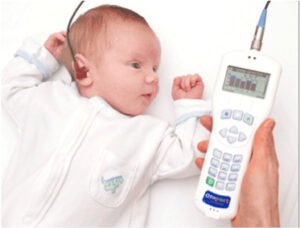Audiology Services -
Otoacoustic Emission Testing (OAE)
Home | Treatments | Ear, Hearing Loss & Audiology | Otoacoustic Emission (OAE) testing
 Otoacoustic emission testing (OAE), can take two forms, either distortion product otoacoustic emission (DPOAE), or transient evoked otoacoustic emission (TEOAE). They are extremely helpful tools in the evaluation of hearing, especially in the pediatric population. In general, OAEs are faint sound signals that emit from the cells known as the outer hair cells located in the cochlea of the inner ear, in response to test sounds.
Otoacoustic emission testing (OAE), can take two forms, either distortion product otoacoustic emission (DPOAE), or transient evoked otoacoustic emission (TEOAE). They are extremely helpful tools in the evaluation of hearing, especially in the pediatric population. In general, OAEs are faint sound signals that emit from the cells known as the outer hair cells located in the cochlea of the inner ear, in response to test sounds.
These emissions are measured by a soft pillow-like plug is placed at the opening of the ear canal. In the middle of the plug are two small speakers and a microphone for recording the responses to a sound stimulus. The responses recorded can give us more information regarding the cochlear portion of the inner ear.
The emissions are extremely soft and therefore it is important for the patient to remain as quiet and still, so as possible to obtain as accurate measurements as possible. OAEs can be used with anyone, but are typically used when testing children when there is a question of hearing impairment. This test does not require the cooperation of the patient, other than that listed above. This is the most common test used for newborn hearing screening in Singapore.
OAEs in children with a normally functioning cochlea will be present and strong. Adults with normally functioning cochleas will have similar results, but not quite as robust as those in children.
Absent or small OAEs could indicate the following issues with the ear:
- Hearing loss (conductive)
- Otitis Media (fluid behind the eardrum)
- Damage to parts of the cochlea (inner ear)
- Our Audiology Services
- Who is An Audiologist?
- Audiology Tests
- Auditory Brainstem Response Testing (ABR)
- Oto-acoustic Emission Testing (OAE)
- Hearing Aids

